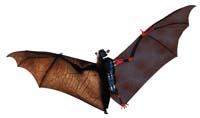To preserve a whole world
2011/09/01 Roa Zubia, Guillermo - Elhuyar Zientzia Iturria: Elhuyar aldizkaria

Iritegi cave is located near Oñati in Gipuzkoa. At the entrance of the cave is a work of art by the sculptor Ibon Aranberri, a large steel door. Prior to the sculpture, he requested authorization from the Provincial Council of Gipuzkoa, obtaining authorization for the construction and installation of a steel door. Months later, from the Oñati Nature Group, he was informed of the importance of the Iritegi cave, due to the existence of a bat colony inside. And then Aranberri turned to UPV zoologists.
Joxerra Aihartza leads the UPV bat research group. "We knew the sculpture because Aranberri himself came. I wanted to ask if it could cause any harm," he recalls. "Of course, such an installation has a huge impact. Fortunately, on the one hand, this cave has two entrances and, on the other, Aranberri had planned in his design a hole in the top. And we do not know why, by the other entrance or by the hole of the sculpture, we believe that the door has not damaged the colony. But it was a kid."
The case of the Iritegi cave is an example of "abandonment" that has suffered the protection of the bat. It does not happen in all cases. In many parts of the world colonies are perfectly protected, in others not. However, there is concern about the conservation of the bat, so 2011 and 2012 have been declared International Year of the Bat for special efforts in favor of conservation.
Pollinators
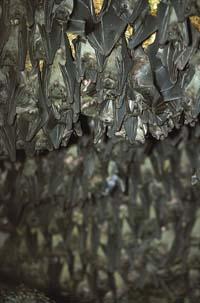
"We have to protect them because they are an important part of biodiversity," says Paul Racey, one of the most prestigious researchers of the emeritus professor and bat at the University of Aberdeen. "In my country, in the UK, the number of bat species is higher than any other mammal species. There are 18 species of bats. So the bat group has more species than the mouse, deer or any other animal." In addition, Racey claims that they control pests and that from an economic point of view the effort to protect bats can also be justified. "The most important service provided by bats worldwide is pollination." In the economy of Southeast Asia, for example, pollinates plants of the genus Durio, which provide fruits of great commercial importance. "In Madagascar they are also of great importance, with six species of baobab and three species pollinated by bats."
Racey is one of the great world leaders in this field. Aiartza himself says: "Racey's research curriculum is terrible. He has worked on bat conservation around the world and has a global vision." That's why Racey talks a lot about the conservation of the bat. And it is not limited to bats. In the middle of his speech he paused and added: "Let me say that we must not justify the right to exist of the fauna that has evolved. Animals and plants have as much right to exist as we do. We have to protect them because they are our inheritance."
The situation of the bat is not the same everywhere. It is a very broad group, very diverse. There are about 1,300 species in the world. And as they live on almost the entire planet, the situation varies greatly from species to species and from habitat to habitat.

What happens with many other animals also happens with bats. Human activity is threatened by the disappearance of shelters, one of the causes of the decline of populations in habitat destruction. "Bat conservation involves habitat conservation," says Aiartza. "They function as guardasol species. To keep a bat in a forest, for example, you must protect the entire community from local arthropods. Total diversity. And plants, etc."
However, the problem is not just habitat. The biggest challenge conservationists have is to protect bats in traditional food areas. Racey knows first-hand examples: "I have been in many of these peoples. What I know best is Madagascar. The capture of bats is not prohibited there. In breeding times it is illegal, but there is no control over this prohibition. And it is traditional food in many tributes. The problem is that bats do not mature like mice. In general, bats only have one breeding a year, so you can't capture many specimens without the population coming down." In Asia there is also a big problem.
Bad image, good image
The organization of the international year, the organization EUROBATS and the UNEP migratory species convention, have highlighted another factor: prejudice against bat.
"In Western countries there is some opposition to the bat," says Racey, but in that sense it is very optimistic, because this attitude has evolved in recent decades. "A lot of work has been done to change the public's vision. When I started working with bats, people called me on the phone to tell me they had bats in houses or churches. 'I want to get rid of them,' they told me. Now, when they call me, they tell me: 'I know they are protected and I don't want to hurt them, but I'm worried if they're going to nest or bite the cables.' Of course, I have to explain that bats do not nidify or bite the wires, since they do not have teeth like rodents. But there has been a profound change in the public perception of the bat, which has been very positive here in Europe."
The EUROBATS organisation has taken care of this work. The organization was created by a multi-government agreement. The agreement has been signed by most European governments, not only for them, but also by the governments of other countries where European migratory bats live. For example, the peoples of North Africa. Many bats living in southern France or Euskal Herria migrate there. These countries are also integrated into EUROBATS.
To the East the situation is much worse. Racey mentions India as an example of an extreme case. "There, some of the biggest bat growers have a bad image, as they eat fruit for trade. In the fruit trees there are 13 species, but most are forest species that never approach the places where there is commercial fruit. And yet in India all bats are classified into the group of savages. Also, by law. How can an animal classified as wild be protected? ".
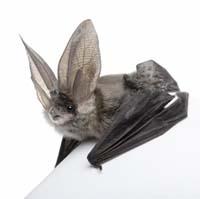
And without such extreme cases, Racey highlights that in many places poor perception does not help conservation: "In Africa, except South Africa, there are no conservation institutions, and states are not interested in bats. There are no conservation institutions in the countries of the former Soviet Union; something has begun in Russia, but in others there is nothing. We also started working in Mongolia and I think there is a hint of hope. In China there is nothing, they have very bad condition."
The case of China is also remarkable, since its tradition has been favorable to bats. "The bat is considered a fortune animal," says Aiartza. "There they have a symbol, Wu Fu, to express five congratulations: power, health, long life, love and virtue," says Aiartza. "And they represent them with five bats. The symbol was taken as an anagram by Bat Conservation International.
And Aiartza says that China is not the only example of a favorable tradition. "In Australia there are flying foxes, large bat fruit trees. When they find a baby who has fallen there or who has run out of a mother, people offer to raise that animal until he is an age and then release it. As for children there are babysitter, for the bat there is batsitter. Bat fruit trees awaken people's tenderness by their big eyes. They are very expressive and, moreover, as they eat fruit, it is very easy to eat them."
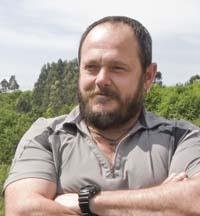
Murciélago Pérez
The Basque tradition has been in favor of the bat, at least of the rural world. "In Arratia, for example, and it is the same in many places in Navarra, when a child loses a tooth he does not give it to the bat Perez, but is thrown to bats. The tooth is thrown at the roof of the house at night. And there is a song: The old bat, the old yew, brings the new, the funny bat. There are different versions. Children sing that, throw the tooth and receive a prize or whatever. This means that the bat has not been considered a bad animal."
When Aihartza and the members of the group dedicated themselves to sampling for research, the baserritarras told them that the bats must be cared for. "We go to a hermitage in search of the bat and they told us "Eh! Don't harm them.' And we would not harm them." If bat feces ever stained too much, baserritarras smoked bats to move them from place to place using smoke. "But not any smoke," says Aiartza. "An old grandfather told me that they burned green grass and that steam moved the bats. In the portico of a hermitage, before the door, for example, to the rear of the hermitage or to the adjoining block. This does not cause problems. It goes human, but it never hurts."
Tourist hook
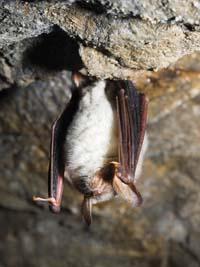
If tradition is favorable or unfavorable, the lack of efforts to protect it causes harm. In the Autonomous Community of the Basque Country this is a big problem. Populations should be monitored, as well as elsewhere in the environment. "In Iparralde there are also many more things in favor of conservation," he explains. In short, in his opinion, more money should be included in conservation than is currently included.
And you can address ideas that you have developed elsewhere. "In many places bats are used to attract tourism, why not? ". The most surprising case in the world is that of Austin, in the United States. At the foot of a bridge over the Colorado River is a colony of one million units, to which people from all over the world come.
At another level, but in the Autonomous Community of the Basque Country, for example, this idea is also applicable, according to Aiartza. "I have said many times: why will we not use this idea here in the caves here? Pozalaguan or whatever. If you have a bat colony, put on a video camera, an ultrasound headset, a monitor to see how animals come out and use them for environmental education, but without harming animals."
The truth is that the approach to the caves has awakened in many cases the hobby, even in those who have subsequently investigated bats. Examples in Aiartza's own group. And if some have reached the point of research, there is no doubt that public perception and conservation of these animals also contribute directly.

Gai honi buruzko eduki gehiago
Elhuyarrek garatutako teknologia





